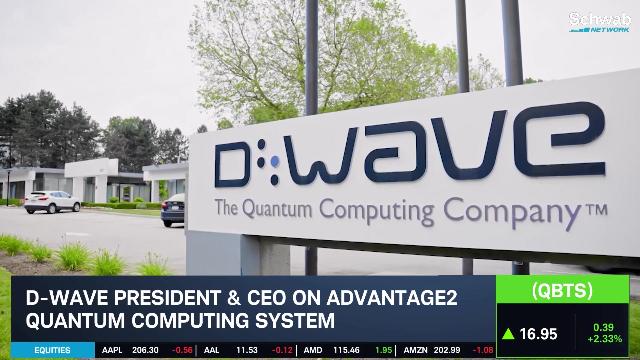- Market Minute
- Posts
- Market Minute: Weekend Spotlight on D-Wave (QBTS) and the Commercial Possibilities of Quantum Computing
Market Minute: Weekend Spotlight on D-Wave (QBTS) and the Commercial Possibilities of Quantum Computing

Alan Baratz, CEO of D-Wave Quantum (QBTS), joins the Schwab Network to discuss the business and the future of quantum computing. They are a “full stack” quantum computing company – they design and manufacture the computers as well as selling them. They also offer services like cloud computing options and allow developers to build applications using their platform. “We are quite unique in the quantum industry… “annealing” allowed us to become truly commercial before anyone in the industry.”
What is Annealing?
I covered the basics of quantum computing in my last article here. With those in mind, let’s dive deeper.
To anneal something is to “heat and then cool” a material, usually steel or glass, “usually for softening and making less brittle.” (Merriam Webster). In genetics, it means joining DNA or RNA strands, again with heating and cooling.
Quantum annealing, then, is a way of solving optimization problems – figuring out the way to do things that costs the least amount of energy. It does this using quantum fluctuations (stay with me).
Quantum fluctuations are a confusing concept. The University of Oxford posits that they could be “the source of dark energy.” In general, they are “erratic changes in energy levels and rates observed in quantum systems.” (Science Direct)
MIT describes it as a “calm sea that suddenly gets waves.” Remember in the last column, we talked about how quantum particles can be simultaneously two things at once? This is a related observation – the unpredictable movement of quantum particles creates energy spikes even in a vacuum.
Ok, so that means quantum annealing is using this fluctuation of hot and cold – energy and vacuum – to figure out the optimal solution to a complex problem with a lot of variables, such as shipping logistics (which truck should you send each package on for peak efficiency?). It seems like a magic trick! But we can compare it to regular computers’ binary again: 1 and 0 can also mean yes/no – the thing or the absence of the thing. Heat or cold.
The ability to deal with complicated optimization problems is the commercial use: computers are great at organizing data! Now we can do it to an even more complex degree, and faster, with quantum. While this is overall a shallow dive into the field, it is hopefully sufficient to explain the basic mechanics.
Back to the Interview
QBTS shares saw a massive rally off the announcement of its “Advantage2” supercomputer, their “sixth generation” quantum computer. It boosts the speed and accuracy of solving problems. Specific application examples Baratz offers include a venture in Turkey looking to optimize production of auto bodies, or a company in Japan optimizing cell tower placement, which will lower their infrastructure costs.
An even wilder use Baratz offers is that Advantage2 can calculate the properties of new magnetic materials digitally, without physically rendering the proposed material – something “out of reach” of regular supercomputers. Magnetic materials are used in a variety of tech products, including sensors.
Baratz says their quantum computer solved these problems in “a few minutes, and it would take nearly a million years” for a regular supercomputer to solve (remember the “tunneling” properties of quantum from the last column). “This is the first true demonstration of quantum supremacy,” he adds.
Growth Drivers for D-Wave
Baratz sees two business components: quantum compute as a service through their cloud offering, and “deeper research investigations” that require physical systems. They are already working on “Advantage3,” which will use multiple chips, rather than adding more qubits to a single chip. He also thinks that quantum can integrate into the blockchain, greatly reducing its electricity consumption while still showing the “proof of work” that blockchain’s foundations rest upon. Just in the case of Bitcoin, he says quantum could cut its electricity use by a factor of 1,000.
The stock itself has had a great year: QBTS is up over 120% year-to-date, and up over 1,400% over the last year. It hit a new all-time high of $19.52 just this week. In its 1Q25 report, released on May 8, it recorded revenue of $15 million (+500% year-over-year), with the jump due to the first sale of a quantum computer. It reported a loss per share of $0.02, but said its cash balance of $304.3 million is “sufficient to fund the company to profitability.”
Quantum going commercial is exciting, but the revolution will be slower and less splashy than AI. It will keep solving immense problems that would take human lifetimes with regular computers, organizing the world or testing potential medicines and much more, one qubit at a time. It will lead to breakthroughs in other fields we could never have made before – let’s see what the next decade brings.
Video Spotlight
Featured Clips
Tune in live from 8 a.m. to 5 p.m. ET, or anytime, anywhere, on‑demand.
Or stream it via thinkorswim® and thinkorswim Mobile, available through our broker-dealer affiliate, Charles Schwab & Co., Inc
Please do not reply to this email. Replies are not delivered to Schwab Network. For inquiries or comments, please email [email protected].
See how your information is protected with our privacy statement.
Charles Schwab and all third parties mentioned are separate and unaffiliated, and are not responsible for one another's policies, services or opinions. Schwab Network is brought to you by Charles Schwab Media Productions Company (“CSMPC”). CSMPC is a wholly owned subsidiary of The Charles Schwab Corporation and is not a financial advisor, registered investment advisor, broker-dealer, or futures commission merchant.




